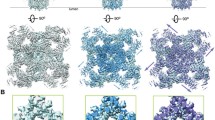Abstract
The temperature effect on cardiac ryanodine receptor (RyR) function has been studied within the electron-conformational (EC) model. It’s shown that a simple EC model with an Arrhenius-like temperature dependence of the “internal” and “external” frictions and a specific thermosensitivity of the tunnelling “open↔closed” transitions can provide both qualitative and quantitative description of the temperature effects for isolated RyRs. The potential of the model was illustrated by explaining the experimental data on the temperature dependence of isolated sheep cardiac RyR gating and conductance (R. Sitsapesan et al., J. Physiol. 434, 469(1991)).
Similar content being viewed by others
References
D. M. Bers, Nature 415, 198 (2002)
R. H. Shutt and S. E. Howlet, Am. J. Physiol. Cell Physiol. 295, C692 (2008).
H. A. Shiels, M. Vornanen, and A. P. Farrell, J. Exp. Biol. 203, 2771 (2000).
T.J. Allen and G. Mikala, Pflugers Arch. 436 (2), 238 (1998).
T. J. Allen, J. Cardiovasc. Electrophysiol. 7 (4), 307 (1996).
C. L. Elias, X. H. Xue, C. R. Marshall, A. Omelchenko, L. V. Hryshko, and G. F. Tibbits, Am. J. Physiol. Cell Physiol. 281, C993 (2001).
R. Sitsapesan, R. A. Montgomery, K. T. MacLeod, and AJ. Williams, J. Physiol. 434, 469 (1991).
D. E. Clapham, Nature 426, 517 (2003).
D. E. Clapham and C. Miller, Proc. Natl. Acad. Sci. USA. 108 (49), 19492 (2011).
Filip Van Petegem, J. Biol. Chem. 287 (38), 31624 (2012).
S. Györke and C. Carries, Pharmacol. Ther. 119, 340 (2008).
A. S. Moskvin, M. P. Philipiev, O. E. Solovyova, P. Kohl, and V. S. Markhasin, Dokl. Biochem. Biophys. 400, 32 (2005).
A. S. Moskvin, M. P. Philipiev, O. E. Solovyova, P. Kohl, and V. S. Markhasin, J. Phys. Conf. Ser. 21, 195 (2005)
A. S. Moskvin, M. P. Philipiev, O. E. Solovyova, P. Kohl, and V. S. Markhasin, Prog. Biophys. Mol. Biol. 90, 88 (2006).
L. A. Irvine, M. S. Jafri, and R. L. Winslow, Biophys. J. 76, 1868 (1999)
A. Jara-Oseguera and L. D. Mas, Biophys. J. 104, 2160 (2013).
A. S. Moskvin, B. I. Iaparov, A. M. Ryvkin, O. E. Solovyova, V. S. Markhasin, JETP Lett. 102, 62 (2015).
D. Colquhoun and A. G. Hawkes, Phil. Trans. R. Soc. Lond. B 300, 1 (1982).
F. Qin, A. Auerbach and F. Sachs, Proc. Biol. Sci. 264 (1380), 375 (1997).
K. Koshino and T. Ogawa, J. Luminesc. 87–89, 642 (2000).
N. Nagaosa and T. Ogawa, Phys. Rev. B 39, 4472 (1989).
A. S. Moskvin, A. M. Ryvkin, O. E. Solovyova, and V. S. Markhasin, JETP Lett. 93, 403 (2011).
A.M. Ryvkin, A. S. Moskvin, O. E. Solovyova, and V. S. Markhasin, Dokl. Biol. Sci. 444, 162 (2012).
M. P. Philipiev, Candidate’s Dissertation (Yekaterinburg, 2007).
A. M. Ryvkin, Candidate’s Dissertation (Pushchino, 2014).
A. M. Ryvkin, N. M. Zorin, A. S. Moskvin, O. E. Solovyova, and V. S. Markhasin, Biophysics (Moscow) 60 (6), 946 (2015).
D. Bers, Excitation–Contraction Coupling and Cardiac Contractile Force (Springer Science Business Media, 2001), vol. 237, p. 105.
W. T. Coffey, Yu. P. Kalmykov, and J. T. Waldron, The Langevin Equation. World Scientific Series in Contemporary Chemical Physics, 3rd ed. (2012).
Unlike [16] here we use a common definition of noise term.
A. Ansari, C. Jones, E. Henry, J. Hofrichter, and W. Eaton, Science 256, 1796–1798 (1992).
S. J. Hagen, Curr. Prot. Pept. Sci. 11, 385–395 (2010).
H. A. Kramers, Physica (Utrecht) 7, 284 (1940).
Author information
Authors and Affiliations
Corresponding author
Additional information
Original Russian Text © A.S. Moskvin, B.I. Iaparov, A.M. Ryvkin, O.E. Solovyova, 2016, published in Biofizika, 2016, Vol. 61, No. 4, pp. 726–735.
The article was translated by the authors.
Rights and permissions
About this article
Cite this article
Moskvin, A.S., Iaparov, B.I., Ryvkin, A.M. et al. The temperature effect on cardiac ryanodine receptor gating and conductance: Mathematical modeling. BIOPHYSICS 61, 614–621 (2016). https://doi.org/10.1134/S0006350916040175
Received:
Accepted:
Published:
Issue Date:
DOI: https://doi.org/10.1134/S0006350916040175




